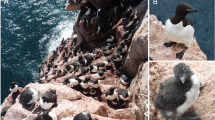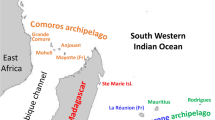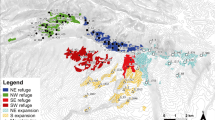Abstract
Genetic variation in 12 populations of sea beet was assessed at nine isozyme and seven RFLP loci. Mean observed heterozygosity, diversity index and number of alleles per locus were not significantly different between the two classes of marker. The genetic structure of 10 of the populations was analysed using seven of the isozymes and six of the RFLPs. FST values between all pairs of populations were calculated separately for the isozymes and RFLPs. FST values were converted to amounts of gene flow (Nm) between populations under the assumptions of an island model. A regression of log Nm against log distance was used to test for isolation by distance. Mantel tests showed a highly significant decrease in Nm with distance for RFLPs but not for isozymes. It is suggested that uniform balancing selection may operate to maintain approximately equal allele frequencies among populations at the isozyme loci. If this is true then isozymes may be unsuitable for modelling the spread of neutral transgenes.
Similar content being viewed by others
Article PDF
References
Avise, J C. 1993. Molecular Markers, Natural History and Evolution. Chapman and Hall, New York and London.
Bailey, N J T. 1959. Statistical Methods in Biology. English Universities Press, London.
Clegg, M T. 1989. Molecular diversity in plant populations. In: Brown, A. H. D., Clegg, M. T., Kahler, A. L. and Weir, B. S. (eds) Plant Population Genetics, Breeding, and Genetic Resources, pp. 98–115. Sinauer Associates, Sunderland MA.
Goudet, J. 1995. FSTAT V-1.2: A computer program to calculate F-statistics. J Hered, 86, 485–486.
Karl, S A, and Avise, J C. 1992. Balancing selection at allozyme loci in oysters: implications from nuclear RFLPs. Science, 256, 100–102.
Lönn, M. 1993. Genetic structure and allozyme-microhabitat associations in Bromus hordeaceus. Oikos, 68, 99–106.
McCauley, D E. 1994. Contrasting the distribution of chloroplast DNA and allozyme polymorphism among local populations of Silene alba: Implications for the study of gene flow in plants. Proc Natl Acad Sci USA, 91, 8127–8131.
Manly, B F J. 1985. The Statistics of Natural Selection on Animal Populations. Chapman and Hall, London.
Mantel, N. 1967. The detection of disease clustering and a generalised regression approach. Cancer Res, 27, 209–220.
Mitton, J B. 1989. Physiological and demographic variation associated with allozyme variation. In: Soltis, D. E. and Soltis, P. E. (eds) Isozymes in Plant Biology, pp. 126–145. Chapman and Hall, London.
Nei, M. 1987. Molecular Evolutionary Genetics. Columbia University Press, New York.
Nevo, E, Krugman, T, and Beiles, A. 1994. Edaphic natural selection of allozyme polymorphisms in Aegilops peregrina at a Galilee microsite in Israel. Heredity, 72, 109–112.
Prentice, H C, Lönn, M, Lefkovitch, L P, and Runyeon, H. 1995. Associations between allele frequencies in Festuca ovina and habitat variation in the alvar grasslands on the Baltic island of Öland. J Ecoi, 83, 391–402.
Raybould, A F, Goudet, J, Mogg, R J, Gliddon, C J, and Gray, A J. 1996. The genetic structure of a linear population of sea beet (Beta vulgaris ssp. maritima) revealed by isozyme and RFLP analysis. Heredity, 76, 111–117.
Riddoch, B J. 1993. The adaptive significance of electro-phoretic mobility in phosphoglucose isomerase. Biol J Linn Soc, 50, 1–17.
Slatkin, M. 1993. Isolation by distance in equilibrium and non-equilibrium populations. Evolution, 47, 264–279.
Weir, B S, and Cockerham, C C. 1984. Estimating F-statistics for the analysis of population structure. Evolution, 38, 1358–1370.
Wright, S. 1921. Systems of mating, I–V. Genetics, 6, 111–178.
Zhang, Q, Saghai Maroof, M A, and Kleinhofs, A. 1993. Comparative diversity of RFLPs and isozymes within and among populations of Hordeum vulgare ssp. spontaneum. Genetics, 134, 909–916.
Author information
Authors and Affiliations
Rights and permissions
About this article
Cite this article
Raybould, A., Mogg, R. & Clarke, R. The genetic structure of Beta vulgaris ssp. maritima (sea beet) populations: RFLPs and isozymes show different patterns of gene flow. Heredity 77, 245–250 (1996). https://doi.org/10.1038/hdy.1996.138
Received:
Issue date:
DOI: https://doi.org/10.1038/hdy.1996.138
Keywords
This article is cited by
-
Dissecting the plant genome: through new generation molecular markers
Genetic Resources and Crop Evolution (2022)
-
Genetic diversity and population structure of a mini-core subset from the world cowpea (Vigna unguiculata (L.) Walp.) germplasm collection
Scientific Reports (2018)
-
High Genetic Differentiation of Hippophae rhamnoides ssp. yunnanensis (Elaeagnaceae), a Plant Endemic to the Qinghai-Tibet Plateau
Biochemical Genetics (2010)
-
Novel methodology for construction and pruning of quasi-median networks
BMC Bioinformatics (2008)
-
Genetic Variation in Hippophae rhamnoides ssp. sinensis (Elaeagnaceae) Revealed by RAPD Markers
Biochemical Genetics (2006)



